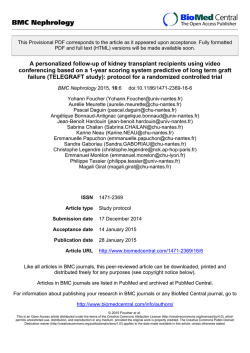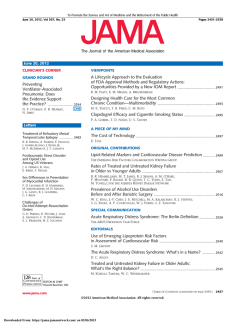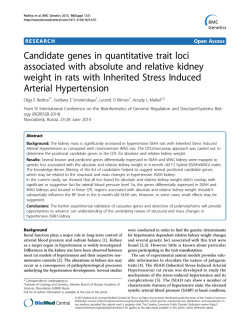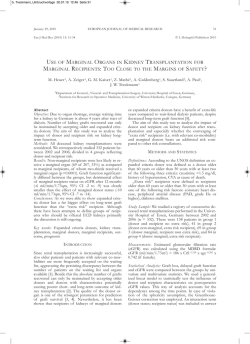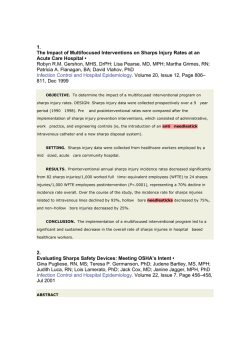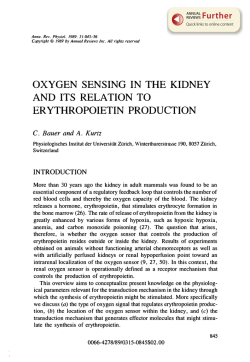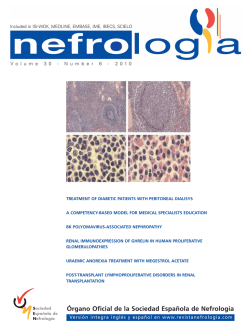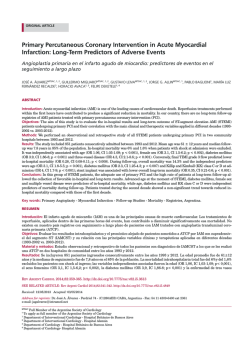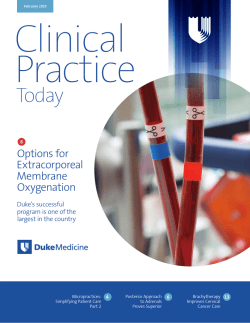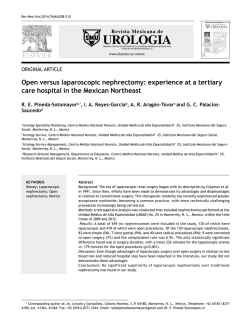
Kidney stone management with percutaneous nephrolithotomy
Rev Mex Urol 2014;74(4):211-215 ÓRGANO OFICIAL DE DIFUSIÓN DE LA SOCIEDAD MEXICANA DE UROLOGÍA, COLEGIO DE PROFESIONISTAS, A.C. www.elsevier.es/uromx Original article Kidney stone management with percutaneous nephrolithotomy: experience at a referral hospital A. Heinze-Rodrígueza,*, R. Suárez-Ibarrolaa, B. N. Várguez-Hernándeza, J. A. VázquezRojasb, L. Gómez-de Regilc, J. A. Aguilar-Morenod, E. Cruz-Nuricumbod and M. VillalobosGollase a Urology Speciality Residency, Hospital Regional de Alta Especialidad de la Península de Yucatán, Mérida, Yuc., Mexico b Undergraduate Internship, School of Medicine, Universidad Nacional Autónoma de México, Mexico City, Mexico c Medical Science Research, Hospital Regional de Alta Especialidad de la Península de Yucatán, Mérida, Yuc., Mexico d Urology Service, Hospital Regional de Alta Especialidad de la Península de Yucatán, Mérida, Yuc., Mexico e Nefrourology Division Management, Hospital Regional de Alta Especialidad de la Península de Yucatán, Mérida, Yuc., Mexico KEYWORDS Percutaneous nephrolithotomy; Kidney stones; Treatment; Lithiasis; Mexico. Abstract Background: Percutaneous nephrolithotomy (PNL) is the treatment of choice for stones > 2 cm and for those of greater density. Aims: The aim of this article was to report on the experience in kidney stone management through PNL at a regional referral hospital center. Methods: A retrospective study was conducted that included patients presenting with kidney stones that underwent PNL at the Hospital de Alta Especialidad de la Península in Yucatán, Mexico, within the time frame of February 2009 and May 2013. Results: A total of 155 kidney units were operated on; 40 men (25.8%) and 115 women (74.2%). The mean age was 44 years and 16 of the patients had only one kidney (10.3%). The stone type was staghorn in 101 cases (65.2%) and the body mass index (BMI) was 27 or higher in 57.4% of the patients. The stone-free rate was 37.3% after the first procedure; the complication rate was 14.3% according to the Clavien-Dindo scale and bleeding was the most frequent negative event. Conclusions: PNL is a safe and efficacious technique in the treatment of kidney stones > 2 cm. Upon treating a high proportion of staghorn stones, the stone-free rate was low and more secondary procedures were required. An in-depth analysis of other factors that could have an influence on the pathophysiology of the disease or treatment results should be carried out. * Corresponding author at: Calle 7 N° 433, por 20 y 22, Fraccionamiento Altabrisa Mérida, C.P. 97130, Mérida, Yuc., México. Telephone: (999) 9427600, ext. 54201. Email: heinze01gmail.com (A. Heinze-Rodríguez). 212 Palabras clave Nefrolitotomía percutánea; Litiasis renal; Tratamiento; Litiasis; México. A. Heinze-Rodríguez et al Manejo de litiasis renal con nefrolitotomía percutánea: experiencia de un hospital de referencia Resumen Introducción: La nefrolitotomía percutánea (NLPC) es el tratamiento de elección para litos > 2 cm y aquellos con mayor densidad. Objetivo: Reportar la experiencia en un centro hospitalario regional de referencia, en el manejo de litiasis renal mediante NLPC. Material y métodos: Se realizó un estudio retrospectivo, que incluyó a los pacientes con litiasis renal sometidos a NLPC dentro del Hospital de Alta Especialidad de la Península de Yucatán, México, desde febrero de 2009 a mayo de 2013. Resultados: Se intervinieron un total de 155 unidades renales, 40 hombres (25.8%) y 115 mujeres (74.2%). La edad promedio fue 44 años. Dieciséis fueron pacientes monorrenos (10.3%). Los litos fueron del tipo coraliforme en 101 casos (65.2%). El 57.4% de los pacientes tenía un índice de masa corporal (IMC) de 27 o más. Con una tasa libre de litos de 37.3% después del primer procedimiento. La tasa de complicaciones fue de 14.3% según la escala de Clavien-Dindo, siendo lo más frecuente el sangrado. Conclusiones: La NLPC es una técnica segura y eficaz en el tratamiento de la litiasis renal > 2 cm. Al tratar una proporción alta de litos coraliformes se encuentra una tasa libre de litos baja y se requieren de más procedimientos secundarios. Se deben analizar a fondo otros factores que pudieran influir en la fisiopatología o los resultados del tratamiento. 0185-4542 © 2014. Revista Mexicana de Urología. Publicado por Elsevier México. Todos los derechos reservados. Introduction Methods Urolithiasis is one of the primary reasons for urologic medical consultation at the health services of the State of Yucatán. Both incidence and prevalence have increased in the last few years.1 A directly proportional relation between prevalence and age has been described. According to the international literature, this entity tends to be more common in men than in women.2-6 Biologic as well as environmental determinants have been considered risk factors for presenting with lithiasis. 3 Included among these are obesity, genetic alterations, low liquid intake, water hardness, chronic degenerative diseases (e.g. diabetes mellitus), high environmental temperatures, metabolic alterations, and neoplasias. In the Mexican population in particular, prevalence is reported at 5.5%, which is a high rate when compared with that of other countries.5-7 Since its description in the 1970s, percutaneous nephrolithotomy (PNL) has become important in the surgical management of this entity.8 PNL is currently regarded as the treatment of choice for stones > 2 cm and those with a high density (> 900 HU).9 PNL complication rates are reported at around 6.7%, and the most common are urinary tract infections (3.3%), bleeding (1.4%), fever (1.7%), and sepsis (1.7%).10 The aim of this article was to report the experience in managing renal lithiasis through PNL at a regional referral center and to describe the characteristics of the patients and the results obtained since the establishment of the Urology Service in 2009. A retrospective study was carried out that included all the patients with renal lithiasis that underwent PNL at the Hospital de Alta Especialidad de la Península de Yucatán, in Mexico, within the time frame of February 2009 and May 2013. The cases were retrieved from the list of programmed surgeries and a thorough review of the medical records was carried out for the purpose of obtaining the demographic and anthropometric information, the preoperative and postoperative biochemical data, clinical data, stone characteristics, surgical variables, and results. The presence of complications was also taken into account. The stones were classified in accordance with the modified Guy classification, 11 adding the variable of multiple infundibular stricture. The complications were coded according to the Clavien-Dindo classification. 11 Stone-free status was considered when there were no stone residuals ≥ 4 mm in the computed tomography (CT) scan. In the case of bilateral stones, each kidney unit was considered separately. Statistical analysis The chi-square test was used to analyze the categorical variables of sex or the presence of complications. Statistical significance was set at a p<0.05. The dimensional scaling variables were analyzed through the Student’s t test. The statistical tests were processed with the SPSS® version 19.0 software. Kidney stone management with percutaneous nephrolithotomy: experience at a referral hospital Results A total of 155 patients were included, 40 (25.8%) of which were men and 115 (74.2%) of which were women. The mean age was 44 years (range: 15-78); 16 patients (10.3%) had a solitary kidney. The majority of stones were of the staghorn type and were present in 101 patients (65.2%), followed by renal pelvic stones in 29 (18.7%), and multiple stones in 10 cases (6.5%). A total of 57.4% of the patients had a body mass index (BMI) of 27 or higher (table 1). Approach through the lower calyx was performed in 71% of the patients, followed by the middle calyx in 26%, and the upper calyx in 6%. The majority were carried out with the patients in the prone position (95%) and 100% were guided by fluoroscopic control. Purulent fluid was retrieved in the initial aspiration in 355 patients, representing 22.6% of the patient total. Renal dilation was performed with Amplatz dilators in 87 cases (56.1%), Alken in 56 (36.1%), and with a balloon dilator in one case (0.6%). A nephrostomy catheter was placed at the end of the procedure in 98.7% of the patients, and only 2 patients (1.3%) were tubeless. Table 1 General characteristics of patients that underwent percutaneous nephrolithotomy Total (percentage) Sex Age Men 115 (74.2%) Women 40 (25.8%) Mean years Range 43.55 BMI Guy classification 15-78 Mean (Kg/m ) Range (Kg/m2) 28.9 18-29 - 44.06 Total (Percentage) I 32 (20%) II 7 (4.5%) III 27 (17.4%) IV 86 (55.5%) 2 Total (Percentage) Solitary kidney Solitary kidney 16 (10.3%) No solitary kidney 139 (89.7%) Total (Percentage) Obstructive stone Yes 28 (18.%1) No 127 (81.9%) Total (Percentage) Number of tracts 1 2 132 (85%) 21 (13.5%) Total (Percentage) PNL kidney Right 82 (53.2%) Left 70 (45.5%) Bilateral 2 (1.3%) Total (Percentage) Disease site Pelvis 29 (18.8%) Upper 1 (0.6%) Middle 3 (1.9%) Lower 10 (6.5%) Multiple calyces 10 (6.5%) Staghorn 101 (65.6%) Total (Percentage) Puncture Upper 213 6 (3.9%) 214 A. Heinze-Rodríguez et al Middle 26 (17.1%) Lower 110 (72.4%) Multiple 10 (6.6%) Total (Percentage) Tachycardia Yes 27 (17.8%) No 130 (84.4%) Stone density HU Mean HU Range HU 1,064 410-2,000 Intraoperative radiation Mean 10.44 minutes Range 3-32 minutes Residual stones Mean mm3 11.63 Range mm3 0-120 Total (Percentage) Stone-free Yes 57 (37.3%) No 96 (62.7%) Total (Percentage) Complications Without complications 132 (85.2%) I 6 (3.9%) II 12 (7.7%) III 0 IV-A 3 (1.9%) IV-B 1 (0.6) V 0 Blood loss mL Mean (mL) Range (mL) 242 20-2,000 Fever Total (Percentage) Yes 24 (15.6%) No 130 (84.4%) HU: Hounsfield units; PNL: Percutaneous nephrolithotomy; BMI: body mass index. We had a stone-free rate of 37.3% after the first procedure. The complication evaluation according to the ClavienDindo classification resulted in a rate of 14.3%. The mean blood loss was 242 mL (range:10-2,000 mL). Discussion Our study population had an inverse relation to that of the international medical literature, a woman:man ratio of 3:1, which could be explained by a higher incidence of stones associated with urinary tract infections. There could also be an endemic component that should be studied in future projects. It is important to mention that the stone characteristics could have an effect on the lithiasis-free rate found in our study; 53% of the population presented with staghorn stones, which could have influenced the success rate being lower than expected.12 In addition, only rigid equipment was previously used, given that flexible equipment and lasers were not available at our hospital until 2013. An important relation was found with respect to the amount of blood loss and the complication rate, which can be partially explained by the fact that the patients that presented with bleeding had to have blood product transfusion and so were classified on the Clavien-Dindo scale with grade II complications. Conclusions PNL is a safe and efficacious technique for treating renal lithiasis with stones > 2 cm. Hormonal, genetic, and environmental factors should be carefully analyzed in relation to its pathophysiology. The present study makes it clear that etiologic studies in the region need to be carried out, due to the demographic variations found in this population. Conflict of interest The authors declare that there is no conflict of interest. Kidney stone management with percutaneous nephrolithotomy: experience at a referral hospital Financial disclosure No financial support was received in relation to this article. References 1. Zeng Q, He Y. Age-specific prevalence of kidney stones in chinese urban inhabitants. Urolithiasis 2013;41:91-93. 2. Boyce CJ, Pickhardt PJ, Lawrence EM, et al. Prevalence of urolithiasis in asymptomatic adults: Objective determination using low dose noncontrast computerized tomography. J Urol 2010;183:1017-1021. 3. Najeeb Q, Masood I, Bhaskar N, et al. Effect of bmi and urinary ph on urolithiasis and its composition. Saudi J Kidney Dis Transpl 2013;24:60-66. 4. Hagikura S, Wakai K, Kawai S, et al. Association of calcium urolithiasis with urokinase P141L and 3’-UTR C>T polymorphisms in a Japanese population. Urolithiasis 2013;41:47-52. 5. Hesse A, Brandle E, Wilbert D, et al. Study on the prevalence and incidence of urolithiasis in Germany comparing the years 1979 vs. 2000. Eur Urol 2003;44:709-713. 215 6. Knoll T, Schubert AB, Fahlenkamp D, et al. Urolithiasis through the ages: Data on more than 200,000 urinary stone analyses. J Urol 2011;185:1304-1311. 7. Medina-Escobedo M, Zaidi M, Real-de Leon E, et al. Urolithiasis prevalence and risk factors in Yucatán, Mexico. Salud Pública Mex 2002;44:541-545. 8. Fernstrom I, Johansson B. Percutaneous pyelolithotomy. A new extraction technique. Scand J Urol Nephrol 1976;10:257-259. 9. Türk C KT, Petrik A, Sarica K, et al. Guidelines on urolithiasis. Eur Urol. 2013. 10. Armitage JN, Withington J, van der Meulen J, et al. Percutaneous nephrolithotomy in England: Practice and outcomes described in the hospital episode statistics database. BJU international 2014;113(5):777-782. 11. Thomas K, Smith NC, Hegarty N, et al. The guy’s stone score-grading the complexity of percutaneous nephrolithotomy procedures. Urology 2011;78:277-281. 12. el-Nahas AR, Eraky I, Shokeir AA, et al. Factors affecting stone-free rate and complications of percutaneous nephrolithotomy for treatment of staghorn stone. Urology 2012;79:1236-1241.
© Copyright 2025
